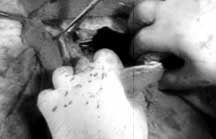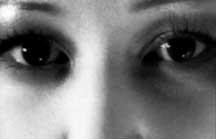
 PHILOSOPHY OF A KNIFE
PHILOSOPHY OF A KNIFEDirected by Andrey Iskanov
Russia-USA/2008—Fullscreen/249 Minutes
DVD Provided by Unearthed Films/TLA Releasing
Article written by Heather Drain
There is nothing scarier than the truth. Which is one of the reasons why I always thought one could make a very good argument for classifying war films as “Horror.” When compared to the effects of war and human intolerance, brain-eating zombies suddenly start looking cute and cuddly. (Well more so than usual.) Anything us creative folks can conjure up will always and eternally be trumped by something that has happened in real life.
Now there have been countless documentaries on war and there have been even more dramatic films, but with PHILOSOPHY OF A KNIFE, you have the strange and lengthy hybrid of the two. There is really nothing quite like this film, at least in my recent memory.
From the very beginning there is a statement that this film is an artistic interpretation of the buildup, operation, and closing of the infamous Japanese Unit 731 during World War II. Now that language would make you expect your basic dramatic type of movie based on fact, right? Not quite, in fact not at all. Instead, what you get is beautifully shot black & white reenactments of various atrocities ranging from a simple decapitation to vivisections to even a girl having bugs inserting in a place that no woman wants them. Nothing is spared visually as Iskanov dives head first into the grue, with more details than anyone would want or expect.
But it’s not just straight up gore in the vein of its predecessor in plot, MAN BEHIND THE SUN (1988). One cannot stress enough how much obvious hard technical work went into this film. Tons of editing, great use of superimposition, effective and shadowy lighting, and the audio, which is always buzzing. If there is a silent moment in PHILOSOPHY OF A KNIFE, it is completely overshadowed by the rest of the soundtrack. The blend of music, which ranges between industrial to nearly symphonic, is blended in well with the thousands of sound effects that are used throughout the 4+ hours running time.
According to the Internet Movie Database, this film took four years to make, which is easily believable. Given how dense it is, I’m surprised it only took them four years. This is a layered piece of work whose ambition definitely took a pair of brass balls to make. How many people are willing to sit through four hours of anything, much less a mix of graphic re-enactment footage along with a few real deal images from one of the most disturbing chapters of World War II, along with the Holocaust and the Rape of Nanking.
But that’s the beautiful thing about art, is that the only responsibility the artist has is to be honest to themselves and their vision, and I have no doubt that Iskanov and company fulfilled it to its absolute zenith.
In addition to the graphic imagery, you have an interview with Anatoly Protasov, who was a doctor and military translator during the 30’s and 40’s in the town of Harbin, which was where Unit 731 was located. Which is interesting, since it really is the only truly classic piece of documentary technique used, other than the odd bits of narration that are used somewhat sporadically.
While the ambition and talent of technique is massive here, it’s not always the most successful of combinations. The running time could have been truncated by at least two hours. There are numerous shots that go on for way too long. The pacing is way too leisurely, which is bizarre given the subject matter. Slow pacing can work, but it definitely cottons better to the subtle.
Then there is the reenactment footage. It is very well done but it suffers from the hazards that come with anything in excess and that it can get repetitive quick. Getting jaded to scenes where people are shitting blood and having their genitals tortured is something one should never to go through, but it’s bound to happen when you are having to sit through literally hours of it. The scenes themselves are often an uneasy match of art and exploitation, with the music video style editing not helping matters at all. The varied acting of the victims also weakens the overall effect. A great actor can make you feel intense pain way more than a well executed gore effect. Not to mention it is easier to get an emotional effect from the audience, when they have some sort of understanding of the characters. Most of the victims here end up being random atrocity fodder.
All that said, I do think the heart of PHILOSOPHY OF A KNIFE is in the right place and it is so lushly constructed that despite its flaws, it does stand out. Anyone that spends that much time and effort to create anything creative has my respect and kudos.
It is, needless to say, not for everyone, but if you’re interested in experimental cinema with a bent towards the extreme, then this could be the film for you. It is not without its flaws, but it does have some things of merit to offer to the brave and patient cineaste.
 |
 |
 |